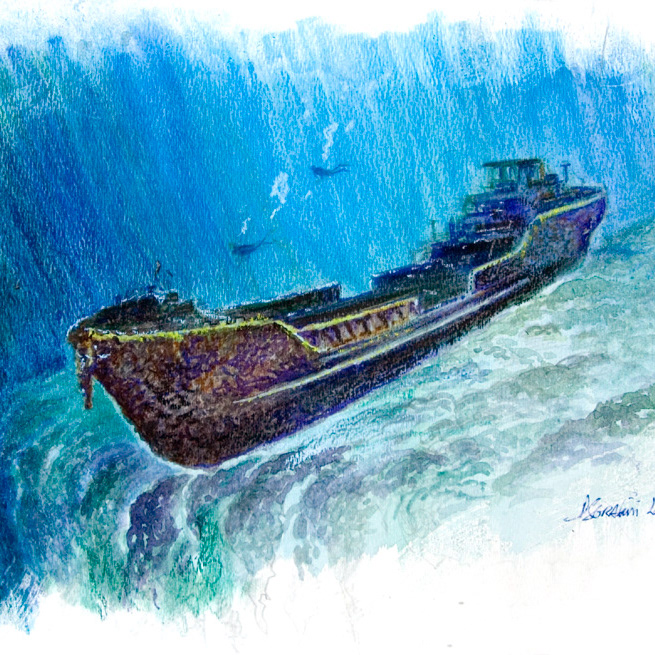In the bay of Saint-Pierre, there is one wreck that captures the imagination of divers - the Titanic of Martinique, The Roraima. At 165 feet, its iron hull is planted on a bed of grey mud. Its large bow stands proud and vertically on the bottom. A dive on the Roraima, is to relive a dramatic historic event.
The sailors and the passengers aboard the boat in May 1902 would have been worried about hurricanes and storms but never would they have imagined being hit by such a cataclysm, sprung from the bowels of the earth.
The Roraima was a mixed cargo vessel, owned by the Quebec Line. It left Montreal, sailed to New York, on to Bermuda, Barbados and finally, it made a stop in Martinique in the bay of Saint-Pierre. After such a long journey, the passengers were happy to make a stop in a harbour, known as the little Paris of the Antilles. Unfortunately, this stop would be their last one - a stop in hell!
The Roraima, Martinique by Dominique Serafini
The Roraima, Martinique by Dominique Serafini
On the morning of May 8, 1902, the passengers were on the deck of the mixed cargo vessel, looking at a spectacular site. Mont Pelée, which dominated the town of Saint-Pierre was covered with clouds. The sky was blue but there were grey clouds. Many passengers took photos, some were looking through binoculars.
The officers of the Roraima knew that the volcano had been active for over a month but the port authorities had assured them that the volcano spitted ashes and sulphur but there was nothing to worry about. On the Roraima, the officers thought they were out of the range of danger. The fast modern steam engines would permit them to escape rapidly if there was a danger and the lava hit the sea.
The cathedral bells rang 8am. Mont Pelée opened up and let loose a fiery cloud - a whirlwind of flames and ashes rose in the sky like a giant dragon. In a few seconds, the whirlwind descended on the town of Saint-Pierre. The passengers of the Roraima look on with horror as the town disappeared under a black shroud.
Boats in the bay exploded in a burst of fire. Sailors on the deck of the Roraima ran in all directions as the captain tried to set sail. But the boat was struck by a tsunami of fire and all are killed by the burning gas. The captain, then blinded, fell into the sea, into the bubbling water. A few on board the Roraima, hidden from the burning cloud, managed to survive and remained on board the smoking carcass of the boat until rescued days later.
115 years later, the sea has changed the wreck of the Roraima. It has put a "carnival" mask of colour on the wreck. Coral and sponges cover the burnt out hull of the ship and dissimulate the scars of the eruption.
Whenever I go into the engine room, or swim down the corridors or on the bridge of the Roraima, I still feel the presence of the victims of this eruption. Even though the lionfish have replaced the sailors and passengers, their phantoms still haunt this dramatic wreck.

The Roraima, Martinique by Cathy Salisbury

The Roraima, Martinique by Cathy Salisbury

The Roraima, Martinique by Cathy Salisbury

The Roraima, Martinique by Cathy Salisbury

The Roraima, Martinique by Cathy Salisbury

The Roraima, Martinique by Cathy Salisbury

The Roraima, Martinique by Cathy Salisbury

The Roraima, Martinique by Cathy Salisbury

The Roraima, Martinique by Cathy Salisbury

The Roraima, Martinique by Cathy Salisbury
If you are interested in knowing more about the wrecks of Saint-Pierre, in 2014, Dominique Serafini wrote and illustrated the book - Saint-Pierre L'escale Infernale. It's a hard cover band dessinée and it is available for sale on the book's website:










